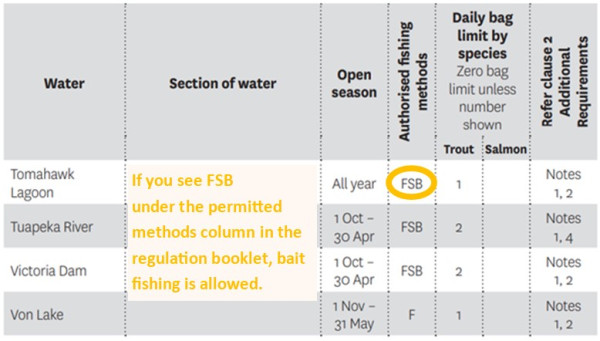Bait Fishing Basics
- 28/02/2024
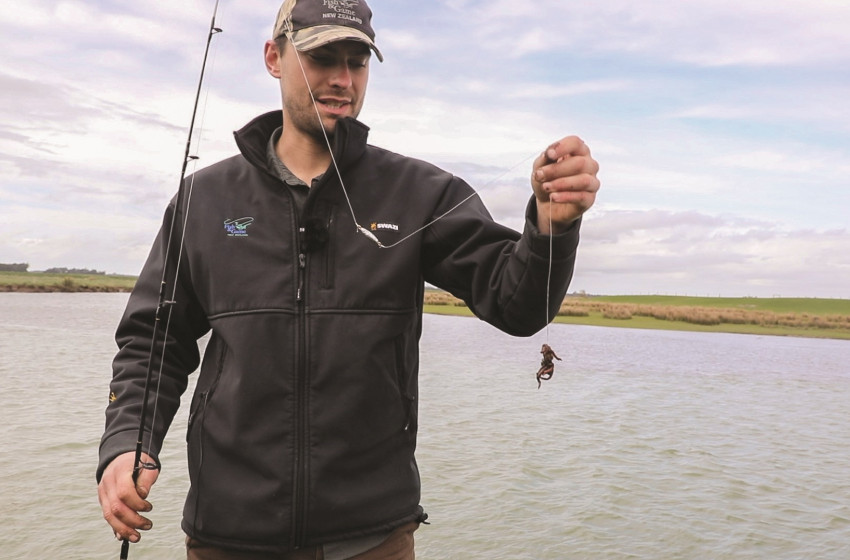
By Cohen Stewart
Trout fishing can be quite challenging, particularly for those who are new to the pursuit.
I can still vividly recall my frustrations as a novice bait angler, struggling to hook a trout, let alone land one.
The trout seemed to constantly outsmart me, leaving me disappointed time and again. Looking back and knowing what I know now, it's not surprising that I struggled, considering the equipment I used and the fundamental fishing basics that I overlooked. It wasn't until a more experienced angler took me under their wing and showed me the fundamentals of bait fishing that I started to have some success.
Click here for a brief video on the basics of bait fishing
I certainly consider myself fortunate to have had someone knowledgeable to share those ‘bait fishing basics’ with me but appreciate that many beginner anglers will not have access to an experienced mentor to help guide them on their journey to trout fishing success. In this article, I aim to bridge that gap for those of you who perhaps struggled to catch a fish last season and are hoping to have a bit more success in the future. For beginner anglers, this article will run through the required essential gear, the proper rigs and bait to use, how to check the fishing regulations to ensure bait fishing is permitted in the area you want to fish, and the prime areas to target when you're next at your local river or lake. By understanding these fundamentals, you'll be well equipped to enhance your bait fishing skills, increase your chances of taking home a trout or two, and hopefully avoid the string of frustrations I had as a beginner angler. Even if you are a skilled angler, the information provided in this article is still relevant and can serve as a guide for introducing your family members, colleagues, children, or grandchildren to the excitement of trout fishing.
Firstly, let’s consider equipment – your rod, reel, and line. Many of my early frustrations as a beginner angler could have been avoided if I had a fishing rod and reel that was suitable for trout fishing. If you are new to the sport, please don’t grab Grandad’s old snapper or cod fishing rod out of the shed and think that you are ready to go trout fishing. It's not recommended to use sea fishing rods and reels for catching trout since they are usually too heavy and not well suited for this purpose. To effectively catch trout on bait, and using lures for that matter, you will need a light spinning rod and reel. The rod should be about 7ft in length and the reel should be small and made to hold 6-8 pound (2.8-3.6kg) breaking strain line. It is important to use this light equipment when targeting trout because it will enable you to cast out your lightly weighted baits effectively and your lures with ease, and because trout can be line shy if your fishing line is too thick, particularly in clear water.
Once you have your fishing rod and reel sorted, you need to think about the bait fishing tackle you will need, the likes of your hooks and sinkers. One of the great things about bait fishing for trout is that the tackle required for the basics is very simple and affordable. You will need a packet of #6 bait holder hooks and a few 1oz barrel sinkers – that’s it. But importantly, you need to make sure your sinker and hook are rigged appropriately. For your bait fishing rig, tie one end of the barrel sinker onto your main line and then you will need to tie on a 50cm long trace (piece of line) on the other end of the barrel sinker. On the end of the trace, tie on a single #6 hook, and you are ready to sink a bait. Check out the diagram that shows what your bait fishing rig should look like. When considering the knot to use, you can’t go past the improved clinch knot for attaching hooks, sinkers, and fishing lures to the line.
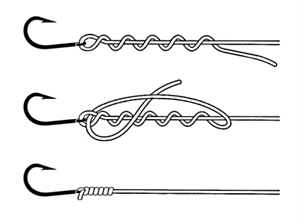
The improved clinch knot
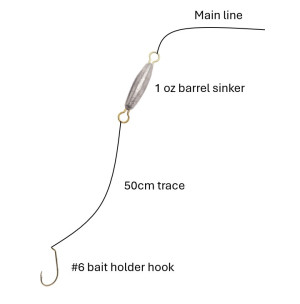
When it comes to bait selection, it is important that you use a permitted bait. Permitted baits are outlined in the first schedule of the regulation booklet that comes with your fishing licence. In most cases, the number one bait is the common garden worm. Worms are a favourite food for trout, have been an effective trout fishing bait for centuries and remain effective to this day. These worms can often be found in your veggie patch, compost pile or under lawn clippings. When searching for worms, the bigger the better. Once collected, place them into an ice cream container or bucket along with some soil to keep them happy. When gathering worms, aim to collect as many as possible. As you begin to have success, you'll quickly go through them. When putting the worm on the hook, put the hook though the area known as the clitellum. This is the thickest and strongest part of the earthworm. The hook can then go through the worm a few times to help keep it on the hook. I like to load up my hook with as many worms as possible. You want to aim for a nice big blob of worms on the end of your hook because once they hit the water, they will start to wiggle. This wiggling attracts the trout, so the more wiggling worms, the better.
An effective bait to consider using, especially in tidal areas of rivers, is smelt. These are small bait fish that enter our lower rivers from the sea in the spring and summer. If you're looking to get some smelt, simply strike up a friendly conversation with a whitebaiter, and they may be willing to share some of their smelt bycatch with you. Use the basic bait fishing rig and attach a smelt to your hook. If you are in a rush, don’t have time to collect worms or smelt for bait and you want convenience, cooked shrimp from the supermarket is a good option. Again, just use the basic bait fishing rig and attach a whole cooked shrimp.
Before you decide to head out bait fishing, it’s important that you check your regulation book to see whether bait fishing is permitted. In the regulation booklet, look up the river or lake you wish to fish in. They are listed alphabetically by region. In the authorised fishing methods column, look for FSB. The F stands for Fly, the S stands for Spin and the B stands for Bait, which means that all legal methods are permitted. If you see just FS or F in a column, this means bait fishing is not permitted.
When deciding on a fishing location, it's crucial to take into account the types of habitats that are appropriate for bait fishing. If you are fishing in a river, you want to look for deep holes or deep slow-moving sections of river. Slow moving tidal areas of rivers are also ideal. You want to select a slow-moving area of water because in these areas the trout will be swimming around actively looking for food rather than sitting in the current drift feeding and waiting for the food to come to them. Keep in mind that one of the advantages of bait fishing is that the river conditions don’t have to be perfect. If the river is elevated and slightly discoloured, bait fishing can still be very effective as trout can use their highly developed sensory systems to locate and detect your bait. If you are fishing in a lake, stream and river mouths are hot spots. Trout will be expecting food to be delivered from the stream or river and into the lake so will be actively swimming around in search of food.
Once you have found your bait fishing spot, you will need to cast out your bait and wait patiently as your bait sits enticingly on the bottom. When casting out your bait, particularly worm baits, be careful you don’t cast too hard, or you will flick the bait off your hook. Once you have cast out, if you can, put your rod in a rod holder or lean it up against a V-shaped stick, and keep the line taut. This will help you to detect any bites. You will know you are getting bites if you see the tip of your rod bouncing and bending. If the trout is hooked, your rod will really start to bend, and then it is just a matter of winding in and carefully landing the trout. If you haven’t had a bite after about 20 minutes, check your bait and cast out into a different part of the pool or slow-moving run.

Keep an eye on your rod tip to detect any bites.
In summary, although trout fishing can be challenging for beginners, if you use the right equipment, appropriate rig, best baits and target the prime areas, you can significantly enhance your chances of success. By applying the ‘bait fishing basics’ as outlined in this article will see you well on your way to bait fishing success. So, gear up, cast out, and good luck with your bait fishing adventures this season.
Permitted baits
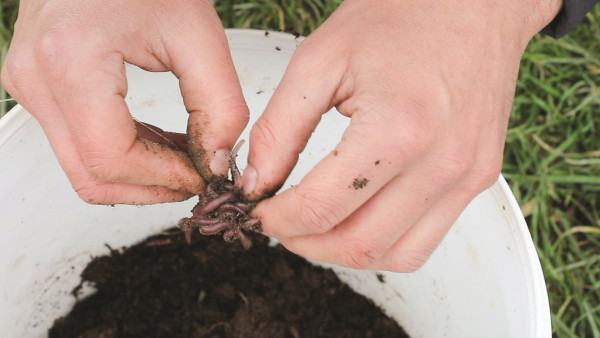
- Natural insect
- Natural spider
- Natural worm or worms
- Natural crustacean
- Whole natural fish
- Uncoloured bread dough
- Scented artificial baits
